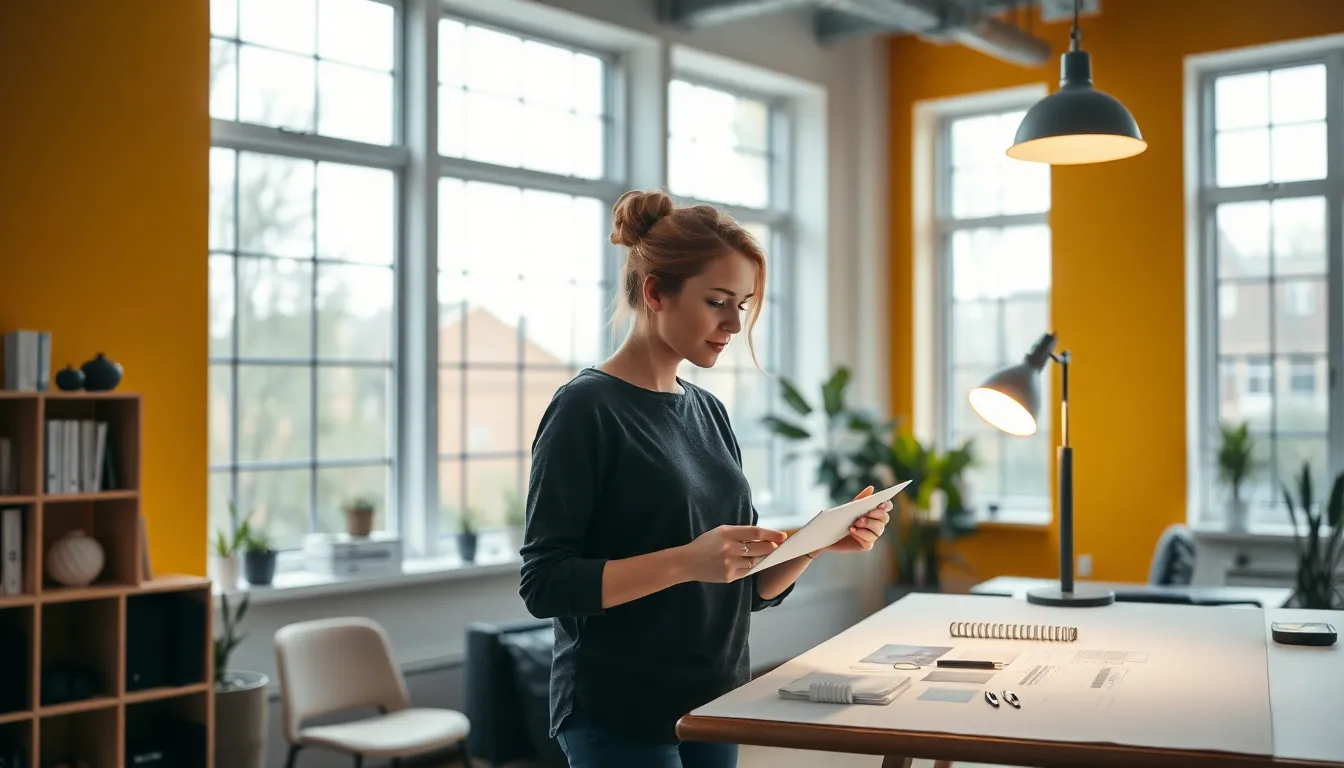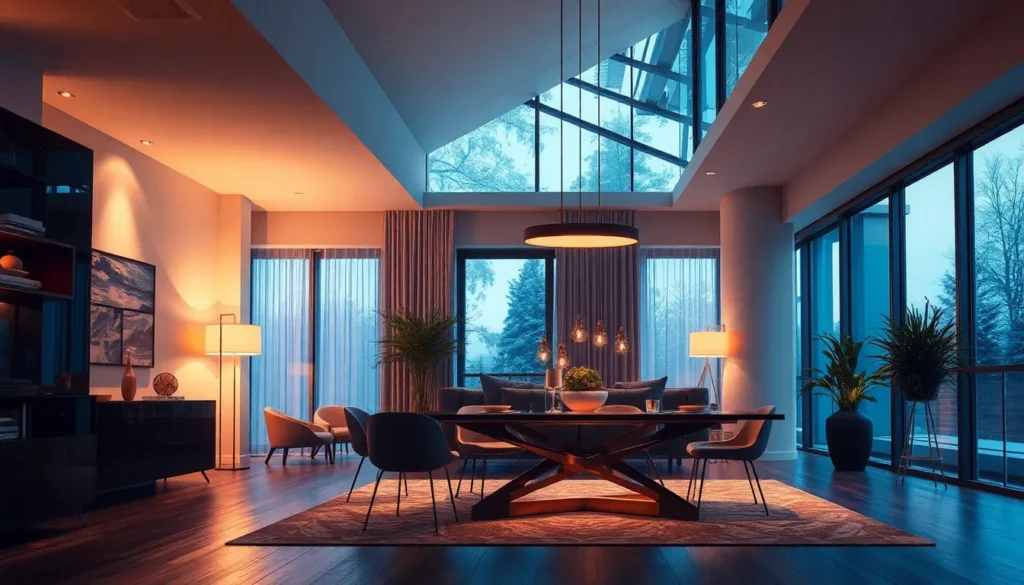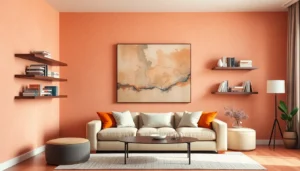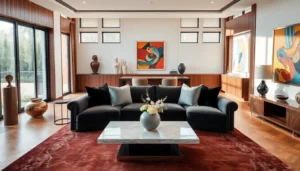Lighting design plays a crucial role in shaping the atmosphere of any space. It influences not just visibility but also mood and functionality, transforming ordinary environments into extraordinary experiences. Whether it’s a cozy home, a bustling restaurant, or a high-tech office, the right lighting can elevate the aesthetic and enhance the overall ambiance.
As technology evolves, so do the possibilities in lighting design. From energy-efficient LEDs to smart lighting systems, designers have a wealth of tools at their disposal to create innovative solutions. Understanding the principles of lighting design is essential for anyone looking to make impactful changes in their environment. With the right approach, lighting can highlight architecture, improve productivity, and even promote well-being.
Table of Contents
ToggleOverview of Lighting Design
Lighting design encompasses the strategic use of light to enhance the aesthetics and functionality of spaces. This field combines art and science to create environments that elicit specific emotional responses and improve practical use. Effective lighting design not only improves visibility in areas like homes, restaurants, and offices but also significantly influences the overall atmosphere.
Lighting designers employ various techniques and principles to achieve their goals. Key considerations include the type of light source, placement, intensity, color temperature, and the interplay between natural and artificial light. Understanding the basic concepts of lighting—such as ambient, task, and accent lighting—facilitates the creation of cohesive lighting schemes that meet the unique needs of each space.
Recent advancements in technology, such as energy-efficient LEDs and smart lighting systems, provide designers innovative tools to fine-tune their designs. These technologies enable the manipulation of lighting settings, allowing it to adapt to different activities and moods throughout the day. Sustainability remains a priority; designers increasingly focus on minimizing energy consumption while maximizing visual comfort.
Incorporating lighting design into a project involves a collaborative approach, often requiring input from architects, interior designers, and clients to ensure alignment with user expectations and functional requirements. This collaboration leads to spaces that not only look aesthetically pleasing but also function effectively, significantly enhancing user experience.
Key Principles of Lighting Design

Effective lighting design relies on a few core principles that enhance both functionality and aesthetics. These principles guide the strategic application of light in diverse spaces, ensuring optimal visual experiences.
Natural Light Integration
Natural light plays a crucial role in enhancing a space’s ambiance and reducing energy consumption. Designers assess daylight availability and optimize window placement to maximize illumination. By incorporating skylights, light tubes, or open spaces, they enhance natural light access. Careful placement of reflective surfaces, like mirrors and light-colored walls, amplifies daylight. Balancing natural and artificial lighting contributes to a sustainable and comfortable environment.
Color Temperature and Light Quality
Color temperature significantly influences the mood and perception of a space. Measured in Kelvin (K), warmer lights (below 3000K) create cozy atmospheres, while cooler lights (above 4000K) promote alertness. Designers choose specific color temperatures based on the intended use of a space. Additionally, light quality impacts visual comfort and task performance. High Color Rendering Index (CRI) bulbs provide accurate color representation, enhancing the overall aesthetic. Ensuring appropriate light quality through selective bulb choices leads to functional and visually engaging environments.
Types of Lighting in Design
Various types of lighting play crucial roles in effective lighting design. Understanding these types aids in creating spaces that are both functional and aesthetically pleasing.
Ambient Lighting
Ambient lighting, also known as general lighting, serves as the primary light source in a space. It fills the room with a comfortable level of brightness, ensuring overall visibility. Common sources include ceiling fixtures, chandeliers, and wall-mounted lights. Designers select ambient lighting based on the room’s purpose and size, adjusting the intensity to fit user needs. Techniques such as using dimmers or multiple fixtures can enhance the flexibility and comfort of ambient lighting.
Task Lighting
Task lighting focuses on specific areas to provide adequate illumination for particular activities. This type of lighting is essential in spaces like kitchens, offices, and reading areas. Sources typically include desk lamps, under-cabinet lighting, and pendant lights. Designers strategically position task lighting to reduce eye strain and improve productivity. Adjustable task lights allow users to control brightness, ensuring optimal conditions for detailed tasks such as reading, cooking, or crafting.
Accent Lighting
Accent lighting highlights specific features or objects within a space, creating visual interest and depth. This type of lighting is effective in showcasing artwork, architectural details, or focal points. Common sources include track lighting, wall sconces, and spotlights. Designers use accent lighting to draw attention without overwhelming the surrounding area. By adjusting the intensity and color of accent lights, designers enhance the aesthetic impact while maintaining balanced lighting throughout the space.
Tools and Technologies for Lighting Design
Lighting design utilizes various tools and technologies to create impactful environments. Software applications, light fixtures, and measurement devices play crucial roles in the design process.
Design Software
- CAD Programs: Designers use Computer-Aided Design (CAD) software to develop detailed lighting plans and visualizations. Programs like AutoCAD streamline the drafting process.
- 3D Visualization Tools: Tools such as SketchUp and Lumion enable designers to create realistic renderings of spaces, allowing for better representation of lighting effects.
- Lighting Simulation Software: Software like DIALux and Relux calculates light distribution, visual comfort, and energy efficiency, providing crucial insights for optimal design.
Smart Lighting Systems
- Smart Bulbs: Intelligent LED bulbs can be controlled remotely, offering customization in brightness and color through smartphone apps or voice commands. Popular options include Philips Hue and LIFX.
- Home Automation: Integrating lighting systems with home automation platforms enhances user control and energy management. Systems like Google Nest and Amazon Alexa provide seamless control.
Measurement Tools
- Light Meters: These devices measure illuminance levels in lux or foot-candles. Designers use light meters to assess the adequacy of lighting in specific areas and make necessary adjustments.
- Color Temperature Meters: These tools evaluate the color temperature of light sources, ensuring that the desired ambient effect and mood are achieved.
Energy Management Technologies
- Sensors and Controls: Incorporating occupancy sensors and daylight harvesting systems adjusts lighting based on presence and natural light availability. This optimization reduces energy consumption.
- LED Technology: LEDs are energy-efficient alternatives to traditional bulbs, providing longer lifespans and lower energy costs. They offer a wide range of color temperatures and CRI options to enhance design quality.
Utilizing these tools and technologies facilitates effective lighting design, enabling designers to create spaces that are visually appealing and functional while promoting sustainability.
The Role of Lighting Design in Sustainability
Lighting design plays a crucial role in promoting sustainability within built environments. It emphasizes energy efficiency, resource conservation, and minimal environmental impact. Designers focus on integrating advanced technologies, such as LED fixtures and smart lighting systems, to reduce energy consumption. These technologies consume up to 75% less energy than traditional incandescent bulbs, dramatically decreasing carbon footprints.
Implementation of natural light is vital in sustainable lighting design. Designers strategically position windows and skylights to maximize daylight, reducing reliance on artificial lighting during daytime hours. This approach not only conserves energy but also improves occupants’ well-being by enhancing mood and productivity.
Use of dynamic lighting controls enhances sustainability further. Technologies like occupancy sensors and daylight harvesting systems automatically adjust light levels based on presence and daylight availability. These systems reduce energy waste, contributing to more efficient lighting usage. For example, studies indicate that occupancy sensors can save up to 30% of lighting energy usage in commercial buildings.
Selection of appropriate materials also influences sustainable lighting design. Eco-friendly materials, such as recycled or sustainably sourced components, minimize environmental impacts. By choosing fixtures and finishes with low volatile organic compounds (VOCs), designers improve indoor air quality and align with sustainable design principles.
Education and engagement of occupants promote responsible lighting use. Informing users about energy-efficient practices encourages them to adopt behaviors that contribute to sustainability. Providing user-friendly interfaces for smart lighting systems allows occupants to easily control lighting levels and usage patterns.
Effective lighting design not only enhances the aesthetic and functional aspects of spaces but also significantly contributes to sustainability efforts. By integrating advanced technologies, maximizing natural light, and educating users, lighting design serves as a powerful tool in promoting environmentally responsible practices.
Effective lighting design is essential for transforming spaces into inviting and functional environments. By skillfully combining natural and artificial light sources designers can create atmospheres that cater to specific needs and enhance user experiences.
The integration of advanced technologies not only boosts aesthetic appeal but also promotes sustainability. As designers continue to explore innovative tools and techniques the potential for creating energy-efficient and visually stunning spaces will only grow.
Ultimately lighting design is more than just illumination; it’s about crafting experiences that resonate with occupants while prioritizing environmental responsibility.






